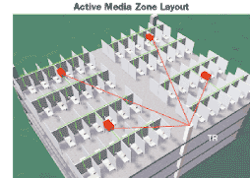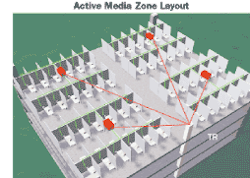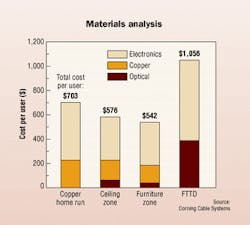Horizontal fiber offers economical distributed active media zone
Information-technology and business managers continue to pursue structured wiring solutions in the local area horizontal network that offer increased revenue and reduced bottom-line cost. Analyst and research firm The Gartner Group (www.gartner.com) projects that more than 70% of transmission networks are considered critical to business operations. Downtime can result in thousands to millions of dollars in business losses.
null
Business expectations are that the critical percentage will increase as e-commerce, Internet use, and network speeds escalate. To address this situation, a distributed active media zone is now available to extend the service life of structured cabling systems. This solution will minimize downtime and lifecycle costs when compared to traditional copper home-run configurations.
What's in the zone?
The active media zone extends optical fiber deeper into the horizontal network to provide ease of installation, optimized data and voice transmission, scalable bandwidth, and easier moves/adds/changes (MACs). Optical-fiber cable is deployed from the equipment room (ER) through a passive telecommunications room (TR) to a horizontal zone location—such as the ceiling, a raised floor, a furniture cabinet, or a furniture office panel—that houses an electronic switch or hub. Short lengths of four-pair unshielded twisted-pair (UTP) copper cable are dropped from the electronics to the wall outlet and to the desktop. Several options are available to power the electronics. Dedicated power can be provided from the TR, or power can be dropped from a power service line in the ceiling.
Often, a media zone box houses electronics in a ceiling environment. Media zone boxes must be plenum-rated in accordance with the National Electrical Code Article 300-22, and with the Canadian Standards Association 22.2 for installations in plenum spaces.
Economic considerations
Even when considering initial installation material costs for the active media zone, traditional copper home runs, and fiber-to-the-desk, the active media zone has an advantage. Depending on the placement of the zone (in furniture or in the ceiling), the savings can range from more than $125 to more than $150 per user over a home-run setup; the savings can be more than $500 over a fiber-to-the-desk design. (Costs are based on a four-floor building with 96 users per floor. One Gigabit Ethernet fiber uplink is used in each case, with a 100-Mbit/sec drop to the desk. The full list price is used for materials, from the equipment room to the network interface card in the PC.)
null
In comparing installation labor and lifecycle costs of the active media zone to traditional copper home runs, estimated labor costs for initial installation and testing of each of the four system configurations show the media zone options saving a minimum of $50 per user over UTP home runs, and saving more than $145 per user over fiber-to-the-desk.
According to the International Facility Management Association (www.ifma.org), 1998 Research Report-16, a 35% churn rate is the mean for business. "Churn rate" is an expression used to demonstrate how often a company will either move or have services added or removed for employees in a 12-month period. Altug Consulting Engineers has reported $365 as an average MAC cost for traditional copper cabling, based on $65 for material and two technicians working for three hours at a billing rate of $50/hour. Communication consultant N'compass Solutions (www.ncompass-inc.com) projects the MAC average cost to be $125 when using the active media zone solution.
Comparing the two MAC scenarios shows the active media zone to offer a 65% cost savings. In addition to the lower MAC cost, end users realize additional savings with the reduced system downtime associated with the MAC work. As previously discussed, this potentially results in thousands of dollars of further cost avoidance.
Standards activity
The Telecommunications Industry Association (TIA—www.tiaonline.org) is taking action to adopt the active media zone concept. In January 2001, BICSI (www.bicsi.org) requested that the TIA consider and potentially provide guidance regarding distributing network electronics to the work area. In March 2001, concurrent with their preliminary efforts to revise the 569 standard, the TIA subcommittee TR-42.3 for building pathways and spaces began discussing distributed electronics in the work area. During that meeting, TR-42.3 established a task group to research and define the concept. Several editorial sessions took place over the next few months to explore and develop the concept.
In August 2001, the TIA subcommittee for commercial building cabling expressed support for certain distributed electronics implementations. As a result, TR-42.3 included those concepts into the first draft of the revised TIA/EIA-569B Pathways and Spaces standard.
At present, the revised TIA/EIA-569B draft standard has undergone two committee ballots containing explicit specifications for a new space called the "telecommunications enclosure"—the generic representation of the Active Zone Box offered by Corning Cable Systems. The 569B standard is set to go out for industry ballot by the end of this year, with hopes for its approval and publishing by the end of 2003.
Optical-fiber recommendations
Corning Cable Systems encourages the use of 50/125-µm multimode fiber, which provides a low-cost, scalable bandwidth solution at the 850-nanometer (nm) operating wavelength. Standards support migration from 10 Mbits/sec to 10 Gbits/sec at 850 nm on 50/125-µm fiber. Currently, the only media solution for 10-Gbit/sec Ethernet is optical-fiber cable.
null
To further support 850-nm bandwidth scalability, in 2001, the TIA released TIA/EIA-785, 100 Mbits/sec Physical Layer Medium Dependent Sublayer and 10 Mbits/sec Auto-Negotiation on 850-nm Fiber Optics—for 100-Mbit/sec operation on multimode fiber. The standard supports 100 Mbits/sec up to 300-meter lengths, which fits well for 1-Gbit/sec, 10-Gbit/sec, and TIA/EIA-568 structured wiring requirements. 62.5/125-µm fiber is also effective, but has distance limitations at higher data rates, such as 10 Gbits/sec.
Optical-fiber cable is now an economical solution in the horizontal LAN space through the use of distributed active media zone architecture. IT and business managers realize increased revenues and reduced costs for their structured wiring systems. Ease of installation, enhanced network performance, reduced MAC costs, and pending TIA standard approval all enhance the use of active media zones in the horizontal.
Doug Coleman is technology and standards manager for Corning Cable Systems' private networks market (www.corning.com/cablesystems).
Benefits of the media zone horizontal layout
- Reduced mean time to repair, as all ports are accessible and easy to troubleshoot.
- Fast and efficient MACs, requiring less downtime
Optical feeder cable remains undisturbed to the zone distribution point
Only copper cables from the distribution point to the work area outlet are relocated
Office-area disruption is minimal - Optical fiber's performance and bandwidth capabilities are extended closer to the desktop
Bandwidth scalability allows migration from 10 Mbits to 10 Gbits
Cable infrastructure enjoys increased longevity - Facilitated deployment of new technology or services to the desktop
- Reduced complexity and installation costs
With only one optical cable per zone, there are fewer cables overall in the horizontal - Increased network efficiency
- Reduced telecommunications room real estate and maintenance costs
Both initial construction and ongoing HVAC costs are reduced - Reduced recurring costs
Break the cycle of replacing/removing abandoned copper cable - Future-ready cabling system
Service life of 25 years or longer - Network to zone diagnostic maintenance
Physical changes only



